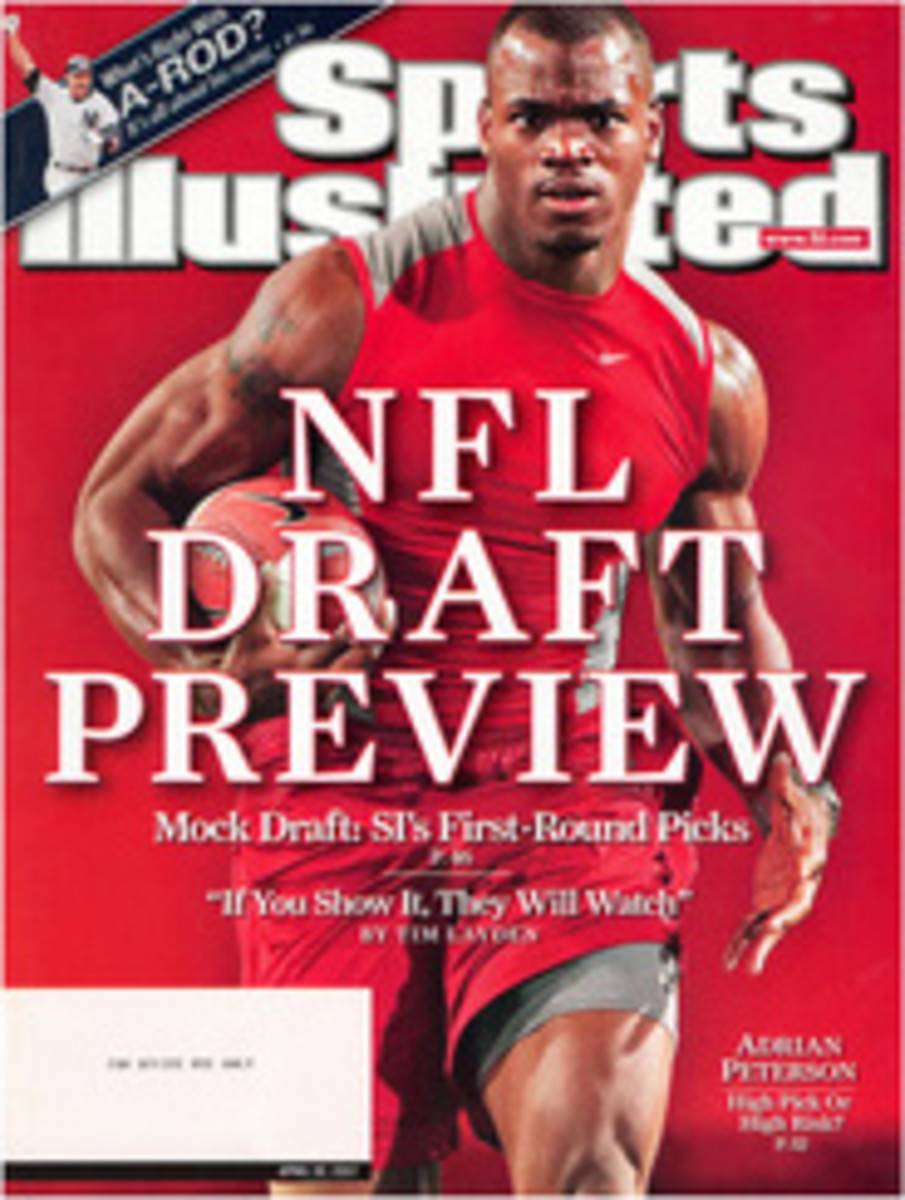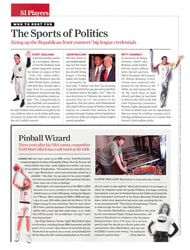
Last Year Is History
Bathed in the glowof three television screens and one laptop computer, Scott Boras, brieflywithout a phone to his ear or baseball owner beneath his thumb, reposed on ablack leather sofa in his two-room, field-level suite last Friday at AngelStadium. The über-agent, dressed in a black wool overcoat and gray mockturtleneck, had the look of a contented day trader, a master of the hardballuniverse tracking his properties--in this case, his clients--in real time. Onthe main big-screen, flat-panel TV appeared his Berkshire Hathaway, New YorkYankees third baseman Alex Rodriguez, the highest-paid and most-deconstructedplayer in baseball.
It was late on the East Coast, in Boston, no less, in a one-run game--exactlythe type of situation that a season ago exposed Rodriguez's vulnerability, evenhis anxiety, as a ballplayer. This year? Boras watched calmly, knowing betterthan just about anybody other than Rodriguez himself that A-Rod, in body andsoul, is a changed man.
Entering this at bat, Rodriguez, 31, had already blasted his way to one of thegreatest starts in baseball history. By the following Tuesday, with a weekstill left in the month, he would join Albert Pujols (2006) as the only playersto smack 14 home runs in April, become the first player ever with a walk-offgrand slam and a walk-off three-run homer in the month, and threaten the Aprilrecord for RBIs (35, by Juan Gonzalez in 1998). He had at least one hit in eachof the Yankees' first 18 games, and, through Monday, New York had yet to win agame without a home run from Rodriguez, who in name only is the same guy sohopelessly lost at the plate at the end of 2006 that manager Joe Torre battedhim eighth in the Yankees' playoff elimination game in Detroit.
More than the"Doubleday ball" in Cooperstown, alleged to have been used inbaseball's mythic first game in 1839, or Babe Ruth's 1932 World Series calledshot, the sport's greatest source of debate might be what's going on insideA-Rod's head. Each operatic turn of his career invites, often with assistancefrom A-Rod's own words, armchair psychoanalysis. His current molten-hot streakis no different. Among the popular theories to explain it: He's more relaxed;he's mentally unburdened after admitting on his first day of spring trainingthat his friendship with teammate Derek Jeter has waned; he's motivated by thepossibility of becoming a free agent, should he exercise the opt-out clause inhis contract after this season. This time, however, Rodriguez's change offortune can be explained almost entirely by real physical changes, most notablya substantial reduction in his body fat and a rebuilt swing for which some ofthe credit goes to a guy who didn't make it out of the minors during his first18 seasons as a player and coach.
"Before springtraining," Boras says, "he told me, 'You know, Scott, I've got it. Ifeel like I have a very repeatable swing.' Everything else--the confidence, theway he carries himself--came because of the swing. The swing camefirst."
The remaking ofA-Rod actually began late last summer when Boras and his team of fitnessexperts suggested to Rodriguez that he might improve his defense, which hadsuddenly become unreliable last season, if he lost some weight. In his threeyears since moving from shortstop to third base after his trade from Texas toNew York, Rodriguez had grown increasingly thick through his chest andrear.
Rodriguez dropped15 pounds over the winter and reduced his body fat from 18% to 10%. That he wassleeker and more nimble was immediately apparent on Opening Day, when he set upthe winning run against the Tampa Bay Devil Rays by stealing second base on hisown. "Last year? No way I even try," Rodriguez says of the theft."Why? Because I would have been out by two feet."
Becoming more fitimproved his hitting, too, as Rodriguez overhauled what last year haddegenerated into a long, overly muscled swing. The work began with the purchaseand installation of a state-of-the-art batting cage in his Miami home, completewith multiple cameras, video monitors, mirrors and a pitching machine."It's the first one he's owned," Boras says.
Meanwhile, lessthan three weeks after their playoff ouster in the Division Series, the Yankeesreplaced bench coach Lee Mazzilli with hitting coach Don Mattingly, who in turnwas succeeded by Kevin Long. It was Long's first major league job. A 31st-roundpick by the Royals in 1989, the 40-year-old Long spent the previous threeseasons as New York's Triple A hitting coach. Long says that Rodriguez was"one of the first people to congratulate me," and A-Rod quickly flew toArizona to meet with Long. Over lunch at a Scottsdale restaurant in November,Rodriguez appealed to Long for help. "I want you to come to Miami,"Rodriguez told him. "I want you to look at film with me, and let's come upwith a game plan for the off-season."
Long studiedvideotape of Rodriguez's swing and in December flew to Miami to work with thethird baseman. For five days Long rarely left Rodriguez's side. They would workout at the University of Miami early each morning, eat breakfast, then work onhitting for several hours at a time in Rodriguez's cage. Long would evenaccompany Rodriguez to his business meetings and charity work in theafternoons. "I was living the life of Alex Rodriguez," Long says.
Rodriguez'sonce-graceful swing had come to resemble the ugly hack of a carnival customerswinging a too-heavy sledgehammer at one of those ring-the-bell-and-win-a-prizebooths. The more he pressed, the worse the results were. Long identified threemajor flaws:
•Rodriguez wouldsometimes drag his back foot forward rather than leave it in place as he beganhis swing, which decreased his leverage.
•He would let hishands drift too far from his body during the swing, making it longer and"looser."
•His front legkick, a trigger mechanism, had become grossly exaggerated. Rodriguez wouldsometimes lift his left knee as high as his waist, then step toward the pitcherwith that leg--a maneuver that would cause him to bring his front foot downlate and violently, which created a tightness and imbalance in his swing.
"His leg kickwas getting to a point where it wasn't getting down on time," Long says."Your front foot has to land when the ball is about halfway to the plate.His was coming down much later than that. When that happens, you have to catchup a lot. You rush, and your body tends to drift [toward the pitcher]."
Long drasticallycut the height of Rodriguez's leg kick and virtually eliminated the stride,instructing him to simply move his left foot up and down, not toward thepitcher. Now Rodriguez's left foot lands much softer and earlier, which getshim into a loaded, better-balanced position to hit. The changes also eliminatedhis drift and allowed him to keep his hands in tighter to his body, improvinghis core rotation. Think of a spinning figure skater: The closer the hands areto the body and the more stable the axis, the faster the skater spins. ForRodriguez, a faster, tighter spin has created better bat speed and power.
Rodriguez groovedhis rebuilt swing through the winter to hit balls on a line into the back ofthe cage's net, an approach that de-emphasized lift and the temptation to pullthe ball. Whereas Rodriguez actually fretted last season about how many homeruns he hit in batting practice, Long has encouraged Rodriguez to maintain hisline-drive approach in batting practice this year. Indeed, A-Rod did not hitone batting practice home run on Friday at cozy Fenway Park.
"He's hitting alot of balls straightaway, and I think it's a good indication that he's not inany rush," Torre says. "Last year he seemed more anxious at the plate.He's not trying to pull the ball. When you are trying to pull the ball as ahitter, you are much easier to pitch to. When you are thinking of hitting itthrough the middle, you get that split second longer to watch the ball andreact to movement."
Rodriguez hit bothof his walk-off homers this month to centerfield, the second coming lastThursday off Cleveland closer Joe Borowski with first base open and two outs, asituation Rodriguez admits would have caused him to "outthink" himselflast year. "I'll tell you what," says eight-time batting champ TonyGwynn, "his swing this year compared to last is night and day. Last year hewas kind of trying to force through the zone. Now it looks like he's justswinging ... no effort, just getting into position."
"He's got awhole different look about him now," San Francisco Giants slugger BarryBonds says. "You can see it in his eyes, even on TV."
Bonds ended lastweek with 740 home runs, 15 short of Hank Aaron's record. With his quick startand 478 career homers--180 more than Bonds had at the same age--Rodriguez hasregenerated discussion that he could be the heir not only to Bonds's finalcareer total but also to his single-season record of 73. "I hope he hits ahundred," Bonds says. "With A-Rod's talent he has a chance to doanything he wants to do, anything he has a mind to do."
Oh, yes: that headagain. Rodriguez has maintained a much lower public profile this year, with thenotable exception of a spring training lapse in which he suggested on a popularNew York radio show that this could be the year, if he doesn't produce, thatNew York fans run him out of town--a slip that brought him a tongue-lashingfrom third base coach Larry Bowa. "Vanilla is the word we use a lot,"Bowa says. "Keep it simple."
Rodriguez keeps hisiPod headphones on before games while the media has access to the clubhouse,avoiding comment. Where once he tried to be expansive and clever after games,now his postgame responses are cordial but clipped.
"A-Rod is likePicasso," Boras says. "He's like a great artist or performer. When thelevel of your performance is so great, whatever you do to present yourself tosociety is never going to match the same level of your performance. So what yousay in explaining yourself and your performance will be held against you byothers. So you realize that what represents you the best is simply the beautyof your performance. Leave it at that."
In his suite Boraswatched on the big-screen TV as Rodriguez, already with two home runs and adouble on Friday, fell short in the ninth this time around, lining out softlyto second base off Boston reliever Hideki Okajima. (Similarly, Rodriguez wouldend a Boston series sweep on Sunday by grounding out with the tying run onbase.)
"You know whatthey'll be saying now in New York," Boras said. "'A-Rod can't hit inthe clutch.'"
Boras said it witha smile and added a small, knowing laugh. Like Rodriguez, he knows that NewYork can measure with an egg timer both sides of its love-hate relationshipswith ballplayers. But he knows, too, that Rodriguez is, in Torre's words,"in a good place and has been ever since spring training." It's a goodplace, known to few others, that is miles and miles from last season.
EXTRA
Daily Scoop
Jon Heyman analyzes how Alex Rodriguez's fast startmight affect his decision whether to remain in New York after this season. ONLYAT SI.COM
2006
"His leg kick was getting to a point where it wasn't getting down ontime," says Long. "When that happens, you have to catch up a lot. YOURUSH, and your body drifts."
2007
Think of a figure skater: The closer the hands are to the body and the morestable the axis, the faster the skater spins. For A-Rod, a TIGHTER SPIN hascreated better bat speed and power.
"A year ago you didn't see the fluidity you donow," Torre says of A-Rod's swing. "It's like, 'I DARE YOU to get meout.'"
PHOTO
Photographs by Chuck Solomon
SPEAK SOFTLY, CARRY A BIG STICK
Besides having a rebuilt swing, Rodriguez has also been more publicly reservedthan he has in the past.
PHOTO
Photographs by Chuck Solomon
[SeeCaption Above.]
PHOTO
ED WOLFSTEIN/ICON SMI
PHOTO
Photographs by Chuck Solomon
PHOTO
Photograph by Erick W. Rasco
RAKER'SDOZEN
Rodriguez became the first player since Mike Schmidt in 1976 to hit 12 homersin the season's first 15 games.

